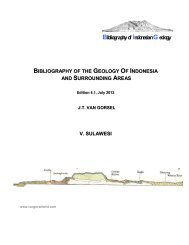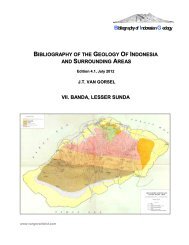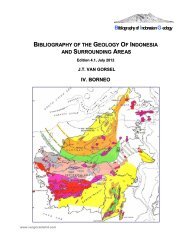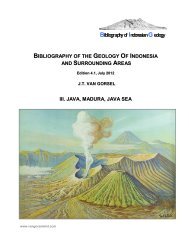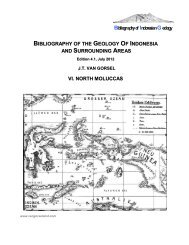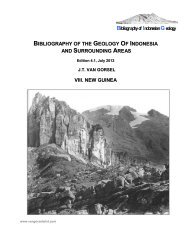Sumatra, Sunda Shelf, Natuna - Bibliography of Indonesia Geology
Sumatra, Sunda Shelf, Natuna - Bibliography of Indonesia Geology
Sumatra, Sunda Shelf, Natuna - Bibliography of Indonesia Geology
Create successful ePaper yourself
Turn your PDF publications into a flip-book with our unique Google optimized e-Paper software.
Clarke, M.C.G., S.A. Ghazali, H. Harahap, Kusyono & B. Stephenson (1982)- The geology <strong>of</strong> the<br />
Pematangsiantar Quadrangle (0718), <strong>Sumatra</strong>. Scale 1:250,000. Geol. Res. Dev. Centre, Bandung, p. + map.<br />
Clarke, M.C.G., W. Kartawa, A. Djunuddin, E. Suganda & M. Bagdja (1982)- The geology <strong>of</strong> the Pakanbaru<br />
Quadrangle (0816), <strong>Sumatra</strong>, 1:250,000. Geol. Res. Dev. Centre, Bandung, 30 p. + map.<br />
Clure, J. (1991)- Spreading centres and their effect on oil generation in the <strong>Sunda</strong> Region. Proc. 20th Ann.<br />
Conv. Indon. Petrol. Assoc., 1, p. 37-49.<br />
(High-T spreading centre subducted beneath <strong>Sumatra</strong>, making cool area warmer. Indian Ocean crustal<br />
thickness thickens away from spreading centres, affecting <strong>Sunda</strong> Craton thermal regimes as spreading centres<br />
collided with craton. Wharton Ridge paleo-spreading centre collided with <strong>Sumatra</strong>n subduction zone and<br />
created ridge/trench triple junction. Collision <strong>of</strong> <strong>Sunda</strong> Craton and W <strong>Sumatra</strong>n spreading centre results in<br />
parts <strong>of</strong> trench with thinner crust and certain locations to be hotter. Outer arc basins usually considered nonprospective<br />
due to low thermal gradients caused by extra thickness <strong>of</strong> crust, but areas where spreading centre<br />
collides will only be slightly greater than one plate thick and warmer, increasing petroleum potential)<br />
Clure, J. (2005)- Fuel resources: oil and gas. In: A.J. Barber, M.J. Crow & J.S. Milsom (eds.) <strong>Sumatra</strong>- geology,<br />
resources and tectonic evolution, Geol. Soc., London, Mem. 31, p. 131-141.<br />
Clure, J. & N. Fiptiani (2002)-Hydrocarbon exploration in the Merang Triangle, South <strong>Sumatra</strong> Basin. Proc.<br />
28th Ann. Conv. Indon. Petrol. Assoc. 1, p. 803-824.<br />
(Merang Triangle, S <strong>of</strong> Jambi, limited exploration. Talang Akar Fm production in Gelam Field in Baturaja<br />
carbonates and further stratigraphic potential highlighted. Plio-Pleistocene Sembilang High structural uplift<br />
resulted in erosion <strong>of</strong> thousands <strong>of</strong> feet. Uplift associated with regional tilt to SE, causing possible re-migration.<br />
Recent faulting broke up carbonate complex and <strong>of</strong>f-reef platform facies now structurally higher than original<br />
reef crest, which resulted in earlier drilling missing build-up)<br />
Cobbing, E.J. (2005)- Granites. In: A.J. Barber, M.J. Crow & J.S. Milsom (eds.) <strong>Sumatra</strong>- geology, resources<br />
and tectonic evolution, Geol. Soc., London, Mem. 31, p. 54-62.<br />
(Carboniferous-Permian and Late Triassic-E Jurassic cycles <strong>of</strong> syn-post collisional granites, peaking at 220-<br />
200 Ma, with tin granites. Younger plutonism associated with arc volcanism, broad age range: 203-5 Ma)<br />
Collins, J.F. & R. Barton (1994)- Arun gas field and LNG plant, geology <strong>of</strong> the petroliferous North <strong>Sumatra</strong><br />
Basin. AAPG, Pre-Conference Field Trip, p. 47-62.<br />
Collins, J.F., A.S. Kristano, J. Bon & C.A. Caughey (1996)- Sequence stratigraphic framework <strong>of</strong> Oligocene<br />
and Miocene carbonates, North <strong>Sumatra</strong> Basin, <strong>Indonesia</strong>. Proc. 25 th Ann. Conv. Indon. Petrol. Assoc. 1, p.<br />
267-279.<br />
(N <strong>Sumatra</strong> Basin Late Eocene - E Miocene early rift, E Miocene N6- N8 sag. Rifting produced N-S trending<br />
subsidence with coarse clastics (Bruksah Fm) in rifts prior to P22, followed by widespread marine shales<br />
(Bampo Fm) from P22 to N4. Foraminiferal mounds accumulated on ramps and crests <strong>of</strong> some rifts, with<br />
transgressions in P22 and N4. Marine Belumai Fm late rift (N4-N6) sands from craton filled grabens.<br />
Unconformity developed above early syn-rift sediments. Sag-phase subsidence accompanied by carbonate<br />
deposition (Peutu Fm) associated with flooding events at N7 and N8. On S structures transgressive platforms<br />
(N7) overlain by coral reefs or equivalent deep-water carbonates (N8). On craton, carbonate mounds and<br />
buildups overlie thick marine sandstones. Between these areas deep-water limestones and marls)<br />
Courteney, S., P. Cockcr<strong>of</strong>t, R. Lorentz & R. Miller (eds.) (1990)- Introduction. <strong>Indonesia</strong> Oil and Gas Fields<br />
Atlas, 1, North <strong>Sumatra</strong> and <strong>Natuna</strong>, p. 1-11, A1-A3.<br />
(Overview <strong>of</strong> N <strong>Sumatra</strong> oil-gas fields. First discovery by Zijlker in 1885 at Telaga Said (cum. production 8.4<br />
MMBO). Additional oil discoveries at Darat (1899), Perlak (1900), Serang Jaya (1926), Pulau Panjang (1928),<br />
Rantau (1929), Gebang (1936) and Palu Tabuhan (1937), all producing from Miocene Keutapang and Baong<br />
sands. Rantau field produced >200 MMB oil, over half <strong>of</strong> production from Keutapang- Baong play. Additional<br />
<strong>Bibliography</strong> <strong>of</strong> <strong>Indonesia</strong> <strong>Geology</strong> v. 4.1 22 www.vangorselslist.com July 2012



